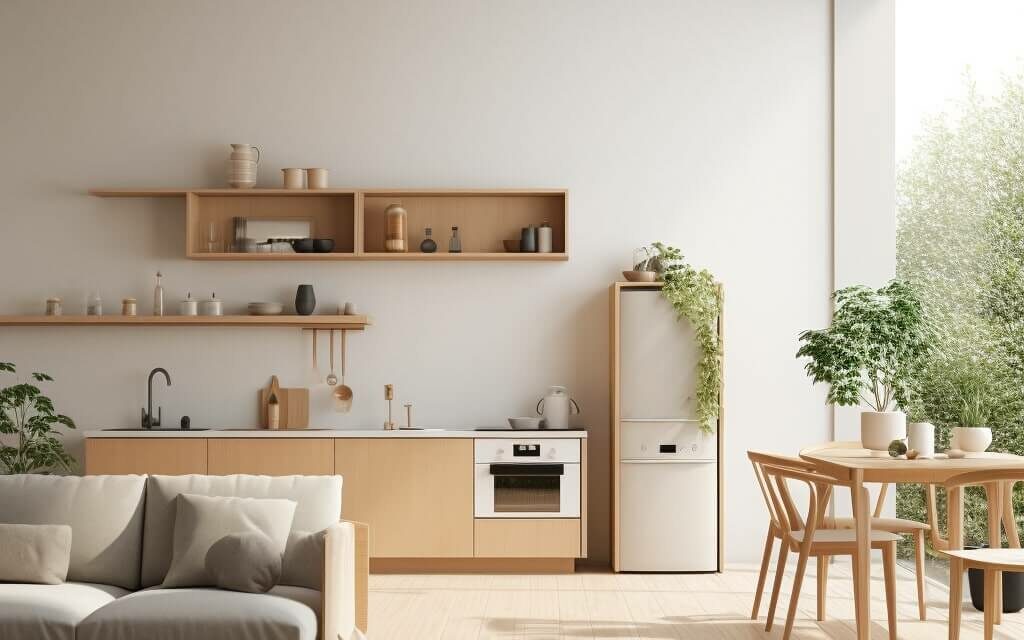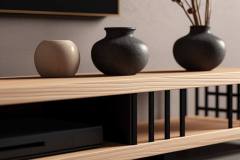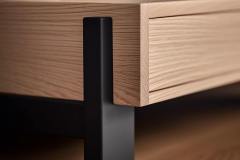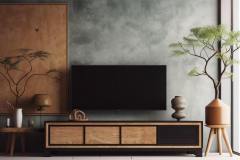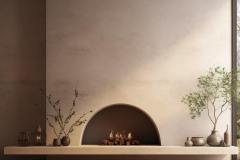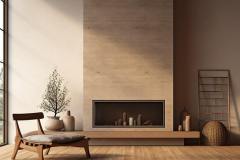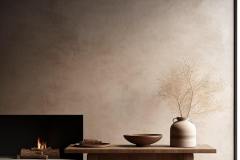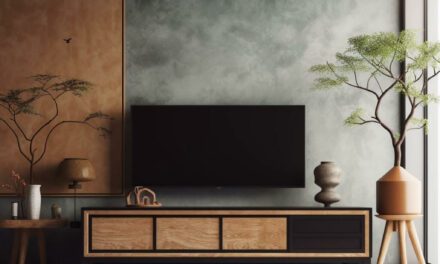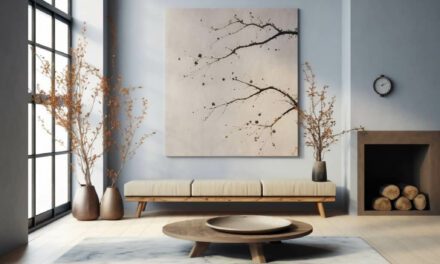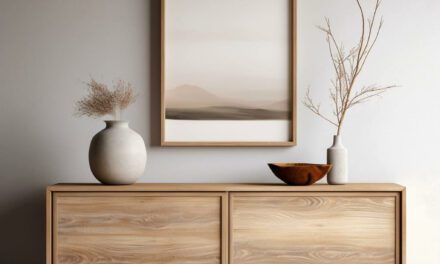One design trend that has been gaining popularity recently is the Japandi house – a fusion of modern Japanese interior design and Scandinavian minimalism.
What makes Japandi so appealing is the harmonious balance it creates between simplicity, functionality, and aesthetic appeal. By combining the clean lines and neutral colors of Scandinavian minimalism with the natural materials and functional simplicity of modern Japanese design, Japandi houses can create a serene and stylish living space.
Key Takeaways:
- The Japandi house is a fusion of modern Japanese interior design and Scandinavian minimalism.
- Japandi design creates a harmonious balance between simplicity, functionality, and aesthetic appeal.
- Natural materials, clean lines, and neutral colors are key elements of Japandi design.
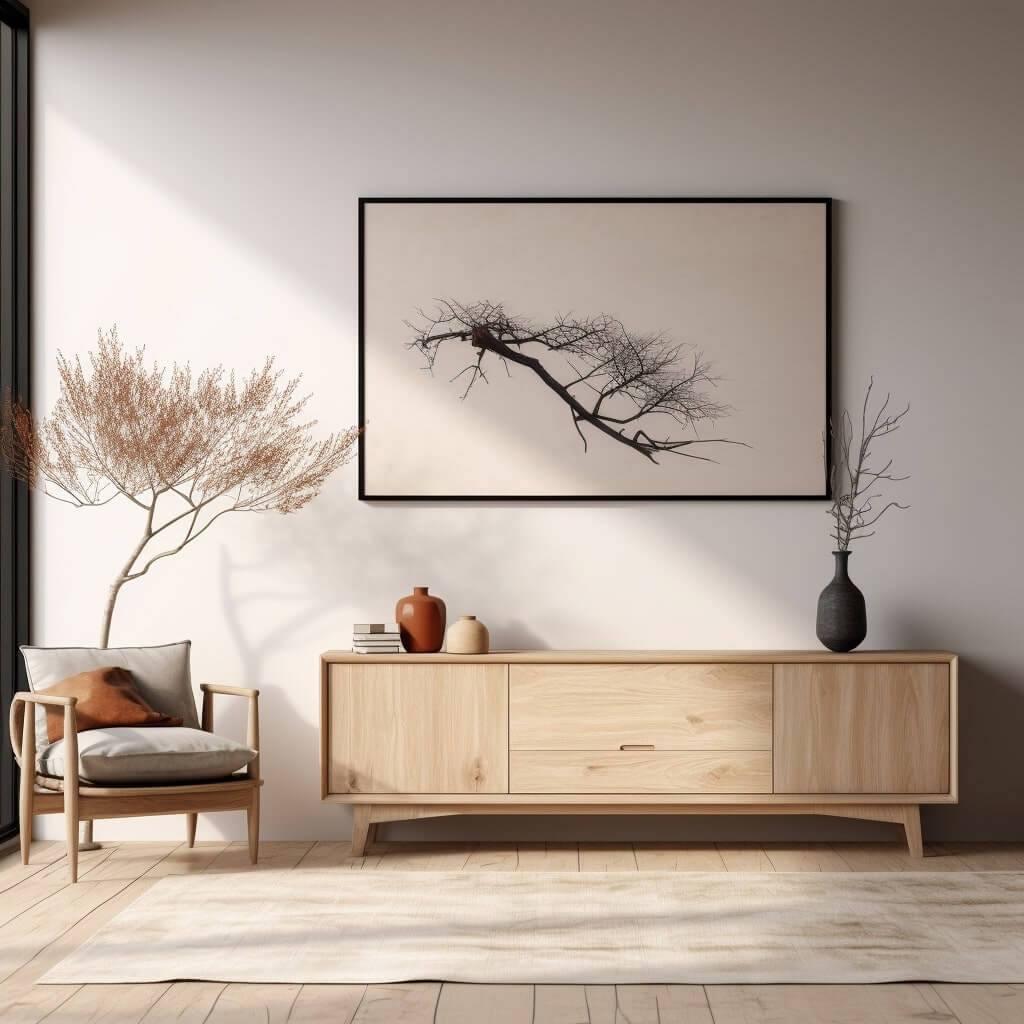
Japandi: A Serene and Stylish Home Environment
Creating a Japandi house means embracing a minimalist home decor with a focus on functional simplicity. It is a fusion style that combines the principles of modern Japanese interior design and Scandinavian minimalism, resulting in a serene and stylish living space.
One of the key aspects of a Japandi house is the use of Japandi furniture, which is characterized by its simple yet elegant designs and the use of natural materials. From the clean lines of a wooden table to the subtle curves of a bamboo chair, Japandi furniture embodies the functional simplicity that defines this fusion style.
To create a zen living space, it is essential to incorporate Japandi design elements that highlight the natural beauty of the materials used. The use of natural light and the incorporation of plants, such as bonsai trees or succulents, can also promote a sense of calm and tranquility.
By embracing the Japandi trend, you can transform your home into a serene and stylish living space that reflects modern lifestyles. With minimalist home decor, natural materials, and functional simplicity, a Japandi house is the perfect blend of Japanese and Scandinavian design philosophies.
Japandi House Gallery – Over 200 Ideas
Check out my collection of Japandi house designs, with over 200 examples of different rooms, styles, color palettes and more:
Modern Japanese Interior Design
I find the principles of modern Japanese interior design fascinating. At its core, it values simplicity, natural materials, and a focus on functionality. This philosophy emphasizes the importance of creating a tranquil and uncluttered environment that allows for relaxation and reflection.
To achieve this, modern Japanese design utilizes a minimalist color scheme and an uncluttered layout. Neutral colors such as beige, white, and gray are often used to create a calming backdrop, while natural materials such as wood, stone, and bamboo are incorporated to add warmth and texture to the space. Additionally, furniture is often designed to be multifunctional, allowing for efficient use of space.
Scandinavian Minimalism
One of the key elements of a Japandi house is the use of Scandinavian minimalism, which emphasizes clean lines and neutral tones. This design philosophy prioritizes functionality and simplicity, with an emphasis on creating an uncluttered living space.
Incorporating Scandinavian minimalism into a Japandi house involves using a color palette of whites, greys, and blacks, with occasional pops of muted pastel tones. Furniture is typically sleek and minimalistic, with clean lines and natural materials such as wood and leather prioritized. The focus is on practicality and functionality, with every item in the room contributing to the overall aesthetic.
By embracing Scandinavian minimalism, a Japandi house becomes a haven of tranquility and simplicity, with every element carefully chosen to create a cohesive and visually appealing living space. The combination of Japanese and Scandinavian design philosophies creates an eclectic fusion style that reflects modern lifestyles and aesthetics.
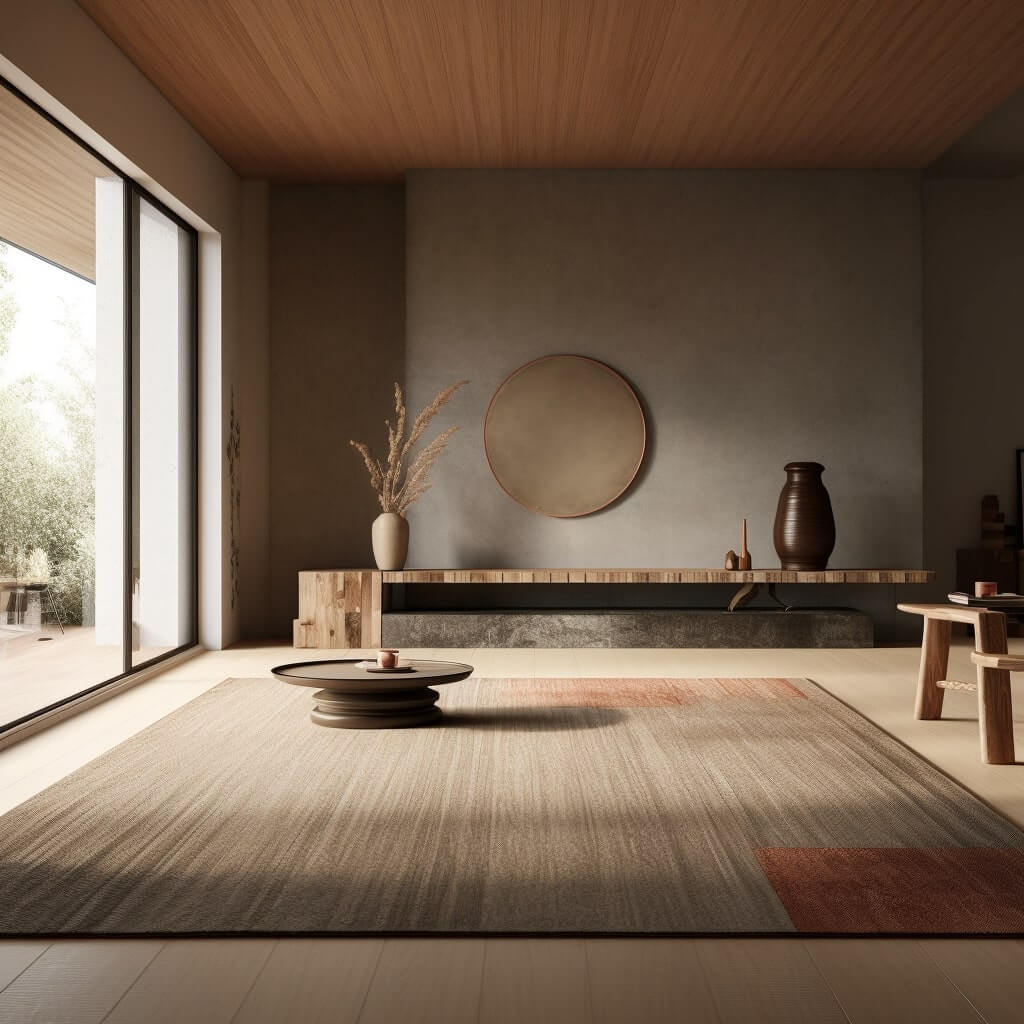
Japandi house – Room by Room
Check out my ideas for each room in a Japandi style house:
Japandi Furniture: The Perfect Blend of Form and Function
When it comes to creating a Japandi house, furniture plays a crucial role in achieving a minimalist and functional style. Japandi furniture is designed with clean lines, simple forms, and natural finishes, making it the perfect fusion of Japanese and Scandinavian aesthetics.
The functional simplicity of Japandi furniture is a hallmark of this design style. From low-lying beds to multifunctional storage solutions, every piece of furniture in a Japandi house serves a purpose beyond its form. This approach encourages a clutter-free living space and promotes a sense of order and calm.
The use of natural materials is also a defining characteristic of Japandi furniture. Wood, bamboo, and other sustainable materials are favored for their aesthetic appeal and environmental benefits. Natural finishes and textures add warmth and depth to the design, enhancing the overall ambiance of the living space.
Japandi furniture is a perfect choice for those seeking to create a minimalist home decor. The design elements of functional simplicity and natural materials promote a sense of harmony and balance, while also providing practicality and efficiency.
Whether you’re looking for a timeless Japandi dining table or a sleek sofa, incorporating Japandi furniture into your home can transform your space into a serene and stylish living environment.
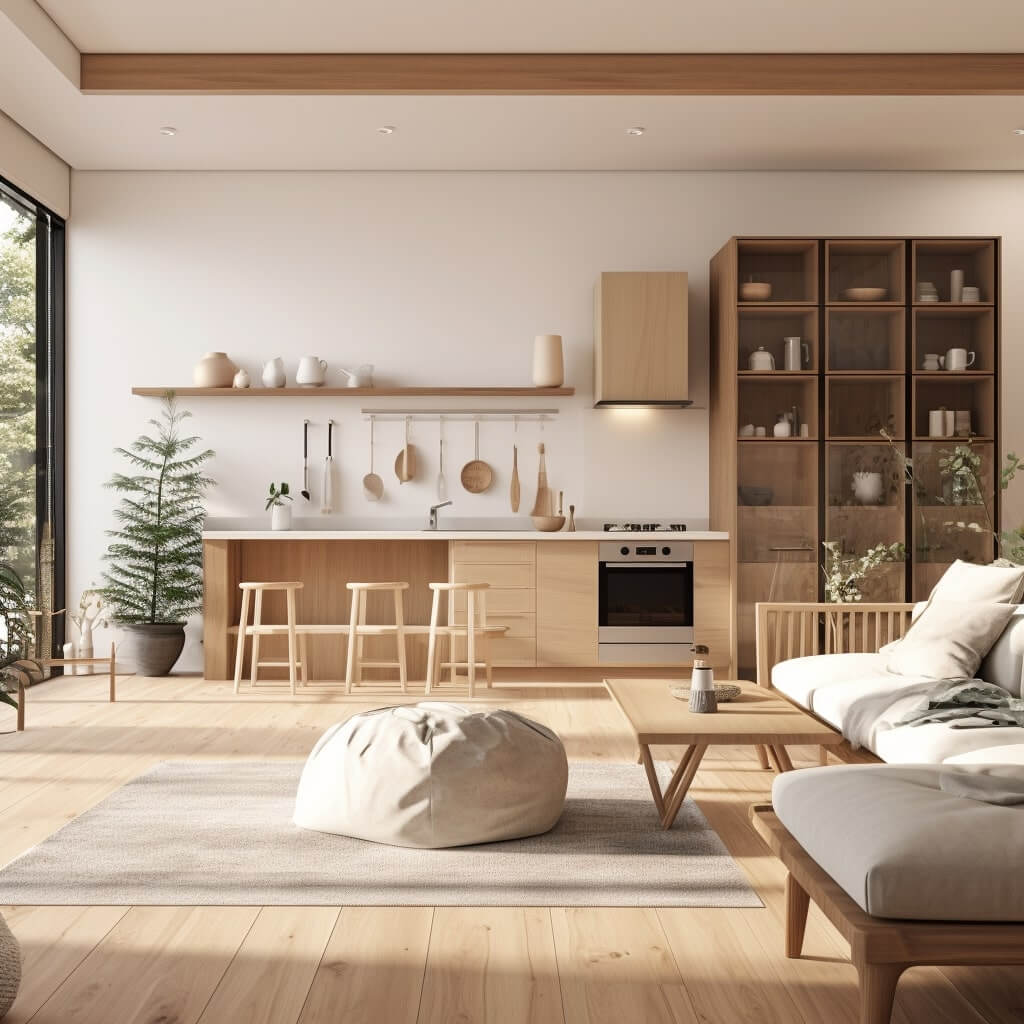
Creating a Zen Living Space: Incorporating Japandi Design Elements
One of the most appealing aspects of a Japandi house is the sense of calm and tranquility it can evoke. By incorporating Japandi design elements, you can create a zen living space that promotes relaxation and mindfulness. Here are some practical tips to achieve this:
- Declutter: A cluttered space can cause unnecessary stress and anxiety. Keep your living space tidy and organized, and only keep items that serve a purpose or bring you joy.
- Natural light: Use natural light to your advantage by keeping windows unobstructed and adding sheer curtains if needed. Natural light promotes a sense of well-being and can make a space feel larger and more open.
- Plants: Incorporating plants into your living space can help purify the air and promote a sense of calm. Choose low-maintenance plants that fit the Japandi aesthetic, such as bamboo or succulents.
When it comes to furniture and decor, keep it simple and functional. Choose Japandi furniture that is made from natural materials, such as wood or bamboo, and has a minimalist design. Avoid pieces that are overly ornate or flashy.
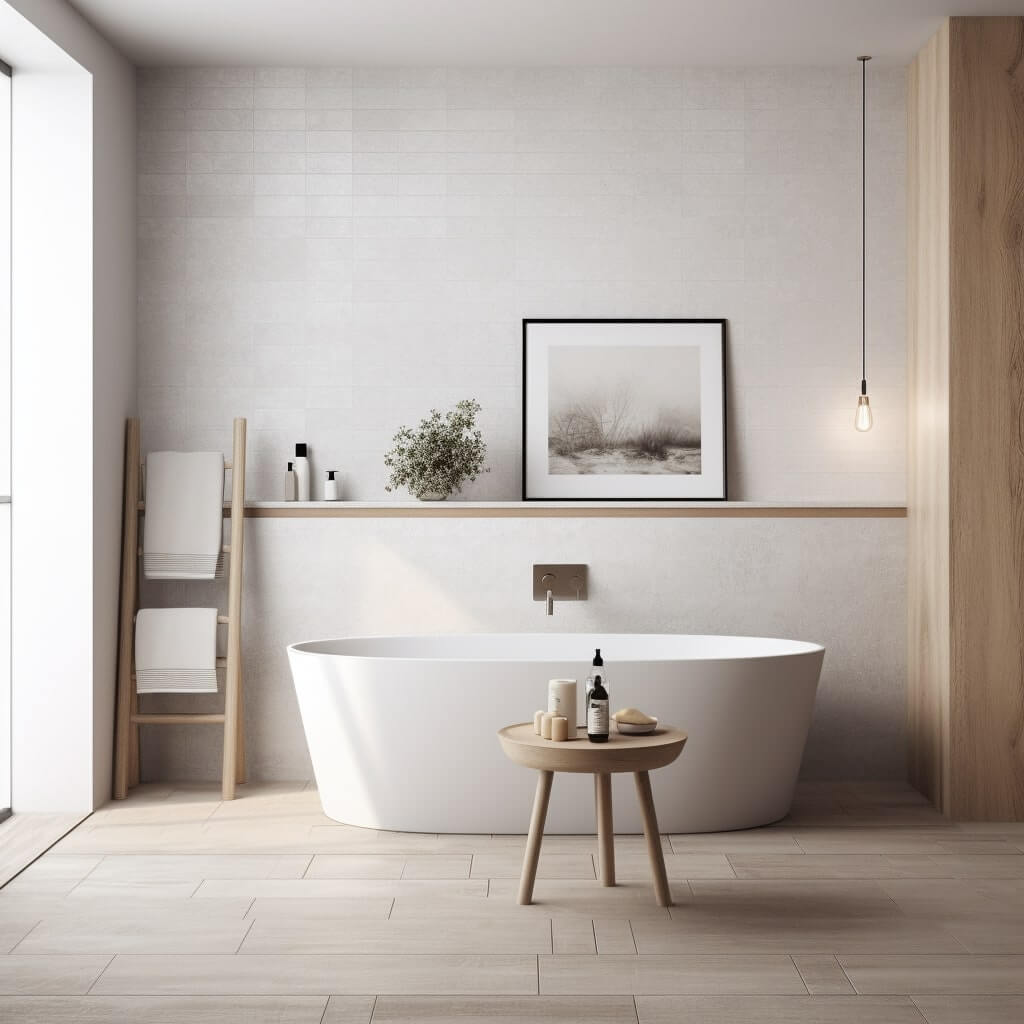
The Appeal of Minimalist Home Decor in Japandi House
As I mentioned earlier, minimalist home decor plays a crucial role in creating a Japandi house. This approach promotes simplicity, functionality, and a sense of calmness in the living environment.
The influence of Scandinavian minimalism and modern Japanese interior design is particularly evident in the Japandi aesthetic. The clean lines, neutral color palettes, and focus on natural materials are all hallmarks of these design philosophies.
Minimalist home decor also has a practical aspect. By removing clutter and unnecessary items, you create more space and make cleaning and organizing much easier. This approach to home design aligns with modern lifestyles, where simplicity and efficiency are highly valued.
However, achieving a minimalist look requires more than just getting rid of things. It involves carefully curating the items you keep and selecting furniture and decor that embody the Japandi style. This approach creates a space that is both visually pleasing and functional.
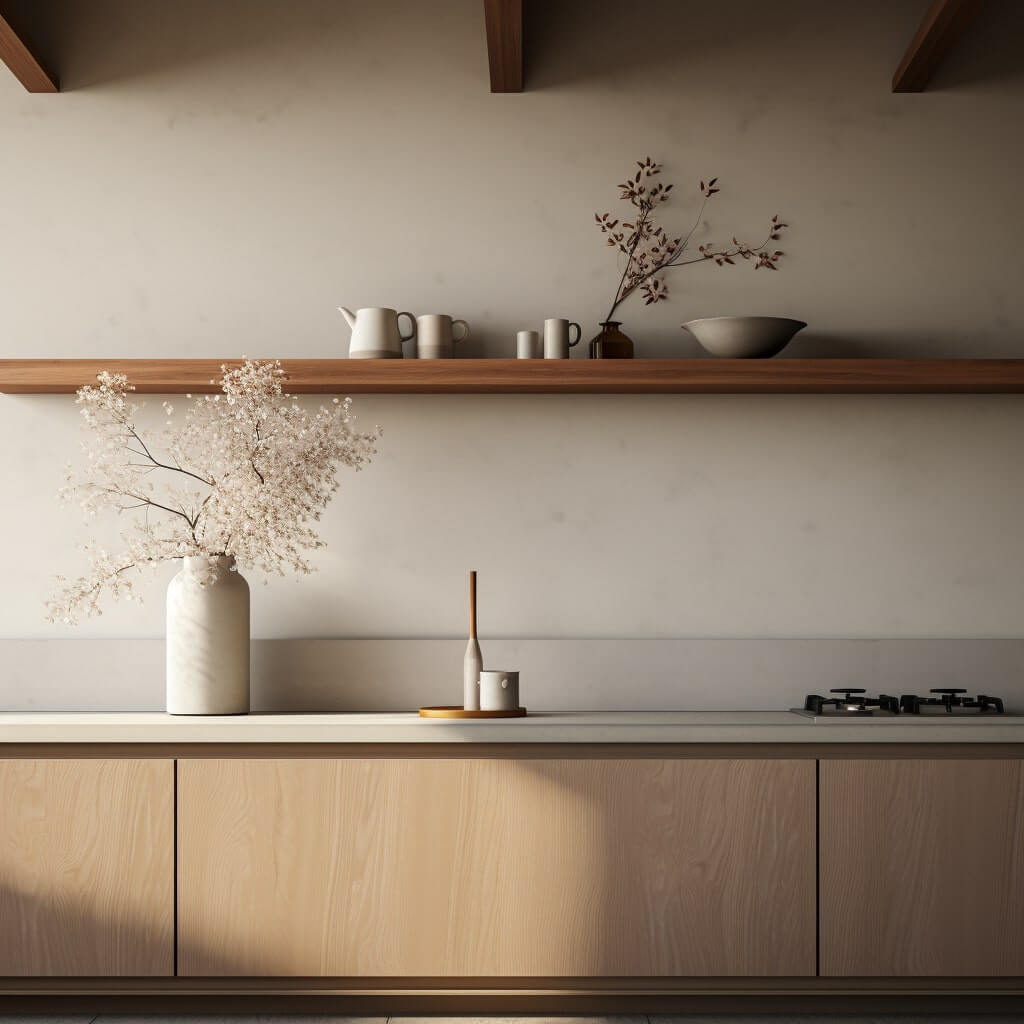
Incorporating Natural Materials for an Organic Feel
One of the essential elements of a Japandi house is the incorporation of natural materials to create an organic feel. This design philosophy aligns with the Japanese philosophy of Wabi-sabi, which appreciates the beauty of imperfection and simplicity.
Whether it’s exposed wood beams, bamboo flooring, or linen textiles, the use of natural materials adds warmth, texture, and a sense of calm to any space. The incorporation of these elements promotes a connection to the environment and encourages a more sustainable approach to living.
| Examples of natural materials in a Japandi house include: | |
|---|---|
| Wood (especially light-toned woods such as oak or ash) | |
| Bamboo | |
| Stone (such as granite or slate) | |
| Linen or cotton fabrics | |
| Rattan or wicker furniture |
When incorporating natural materials, it’s important to consider their sustainability and environmental impact. Opting for materials that are responsibly sourced and manufactured, such as bamboo or FSC-certified wood, can help reduce our ecological footprint while still achieving the desired aesthetic.
By creating a living space that incorporates natural materials, a Japandi house inspires a sense of harmony and balance that can have a positive impact on our overall well-being.
The Functional Simplicity of Japandi House
One of the fundamental principles of the Japandi house style is functional simplicity. This approach focuses on designing spaces that are practical, efficient, and easy to maintain. It values organization, utility, and the elimination of unnecessary clutter in the living environment.
At the core of the Japandi house is a commitment to thoughtful design that maximizes space, minimizes waste, and enhances the quality of life for its occupants. This style emphasizes multi-functional furniture, built-in storage, and modular design to create spaces that are both beautiful and highly functional.
By prioritizing functionality and simplicity, Japandi house also encourages mindful living. It promotes a sense of calm and serenity by reducing distractions and excess possessions, encouraging individuals to focus on what truly matters in their lives.
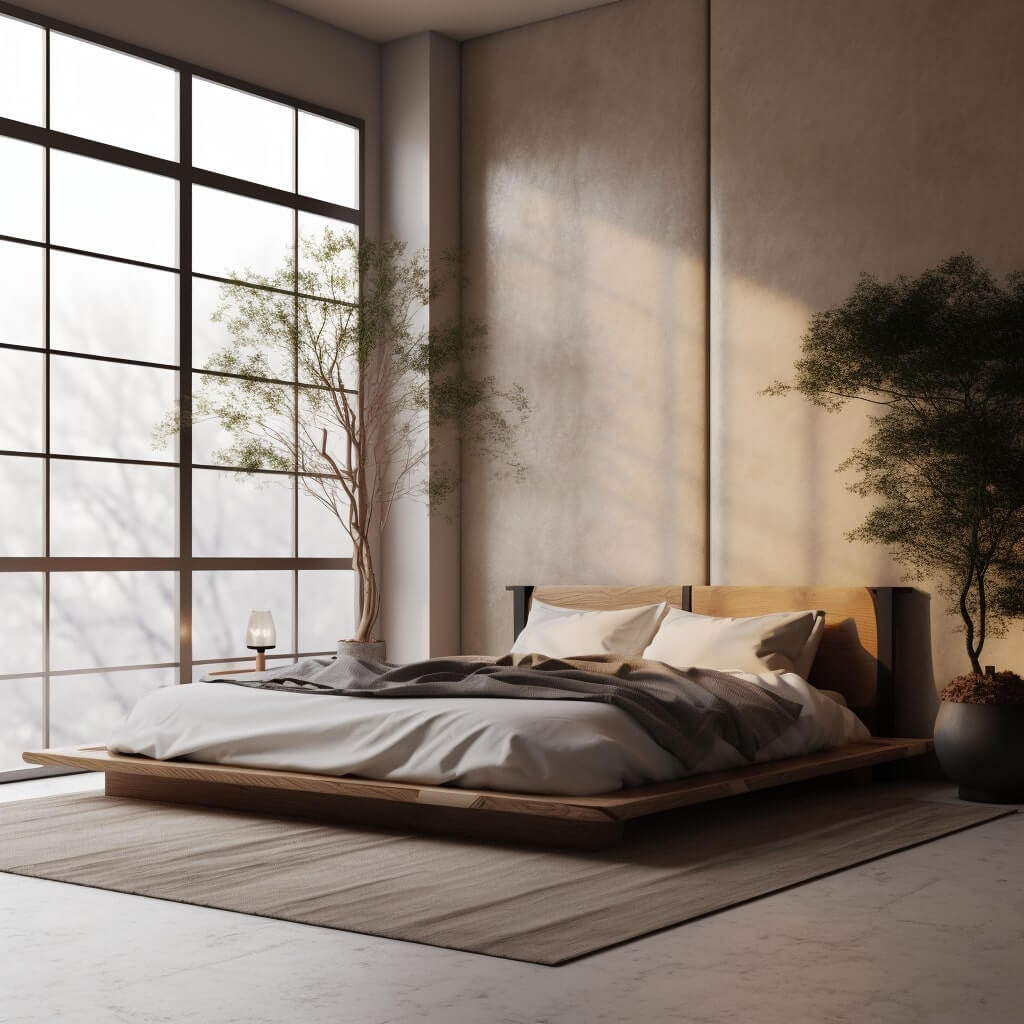
Japandi House: A Reflection of Modern Lifestyles
As our lives become increasingly fast-paced and cluttered with distractions, we naturally yearn for a sense of calm, simplicity, and authenticity in our living spaces. This is where Japandi House comes in, offering a fusion of modern Japanese interior design and Scandinavian minimalism that resonates with individuals seeking balance.
At its core, a Japandi house is a reflection of modern lifestyles, capturing the desire for both tranquility and functionality in a single space. By combining the principles of these two design aesthetics, Japandi House provides a harmonious and balanced environment that is both stylish and practical.
The minimalist approach of a Japandi house favors natural materials and functional simplicity, emphasizing the importance of well-designed, multipurpose furniture and efficient use of space. This approach enhances the functionality and practicality of the living environment while promoting a sense of serenity and simplicity.
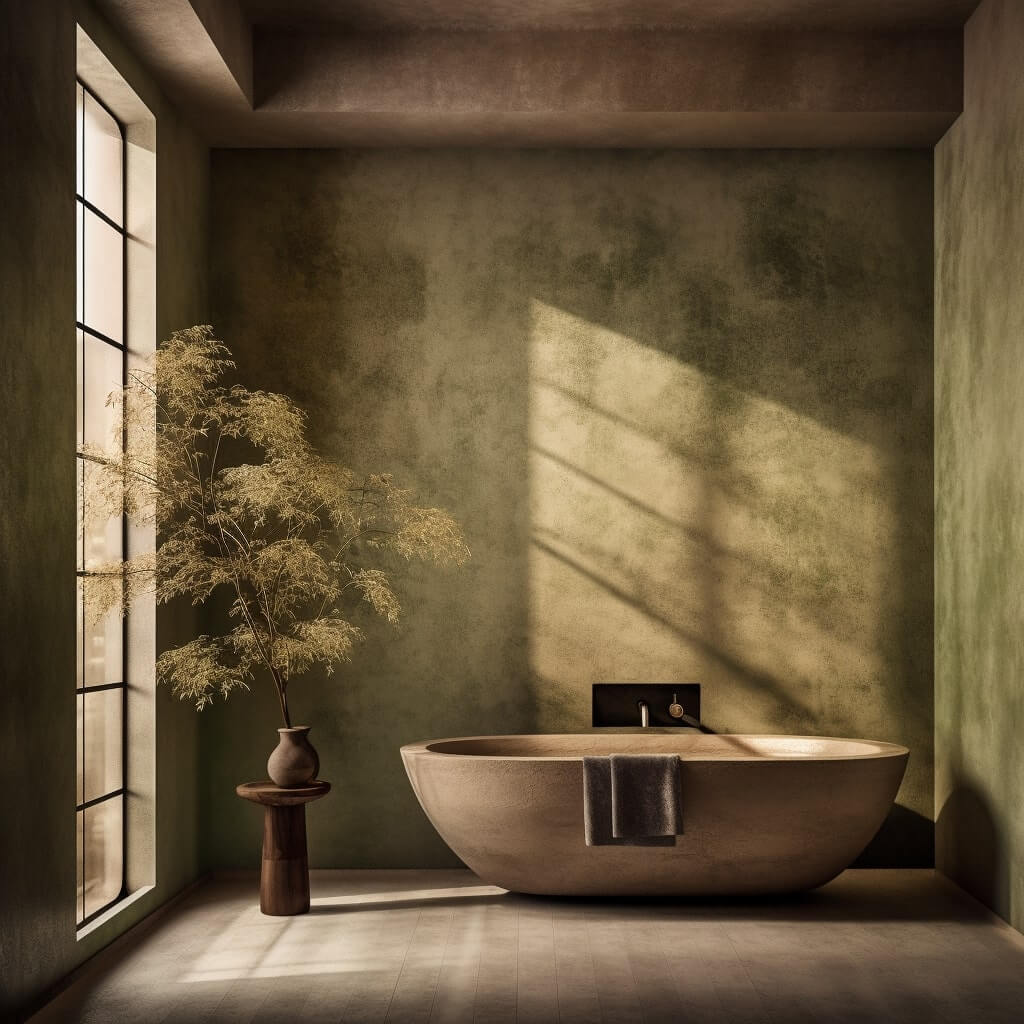
Embrace the Japandi Trend: Transform Your Home Today
As someone who is always on the lookout for fresh design inspirations, I am excited to explore the Japandi trend and share it with you. Japandi is a fusion style that marries the elegant simplicity of modern Japanese interior design with the cozy minimalism of Scandinavian decor. It’s a perfect blend of form and function, resulting in a serene and stylish home environment.
If you’re looking to create a Japandi house, start with minimalist home decor and incorporate Japandi furniture. Clean lines, natural materials, and a neutral color palette are common design elements. Emphasize creating a zen living space by decluttering, using natural light, and adding plants to promote a sense of calmness.
Incorporate Japandi design elements
Some of the most prominent Japandi design elements include the use of natural materials and functional simplicity. Embrace sustainable materials like wood and bamboo for an organic feel. Multipurpose furniture is a must in Japandi house, as it enhances functionality and practicality. It is essential to create a cozy and functional living space that reflects modern lifestyles.
The benefits of Japandi house
The Japandi trend offers several benefits, such as a serene, stylish, and functional living space. This fusion style connects simplicity, authenticity, and nature to achieve a harmonious balance. Japandi house brings comfort, coziness, and peacefulness into your life.
FAQ
Q: What is a Japandi House?
A: A Japandi House is a fusion style that combines the principles of modern Japanese interior design and Scandinavian minimalism. It creates a harmonious and balanced living space by incorporating elements of both styles.
Q: What are the key aspects of a Japandi House?
A: The key aspects of a Japandi House include minimalist home decor, the use of Japandi furniture, creating a zen living space, and incorporating Japandi design elements. These elements contribute to the overall aesthetic and functionality of the home.
Q: How can I incorporate Japandi design elements into my home?
A: You can incorporate Japandi design elements into your home by decluttering, utilizing natural light, and incorporating plants to create a sense of calm and tranquility. The use of natural materials, such as wood and bamboo, is also essential in achieving the Japandi aesthetic.
Q: What are the benefits of minimalist home decor in a Japandi House?
A: Minimalist home decor promotes a sense of serenity and simplicity in a Japandi House. It creates a clutter-free and organized living environment, allowing for better relaxation and focus.
Q: Why are natural materials important in a Japandi House?
A: Natural materials, such as wood and bamboo, are important in a Japandi House because they create an organic feel and align with both Japanese and Scandinavian design philosophies. They add warmth and texture to the space.
Q: How does functional simplicity enhance a Japandi House?
A: Functional simplicity enhances a Japandi House by utilizing well-designed, multipurpose furniture and efficient use of space. It enhances the functionality and practicality of the living environment, creating a more comfortable and organized space.
Q: Why is a Japandi House a reflection of modern lifestyles?
A: A Japandi House reflects and accommodates modern lifestyles by capturing the desire for simplicity, authenticity, and a connection to nature. It resonates with individuals seeking a balance between tranquility and functionality in their living space.
Q: How can I embrace the Japandi trend in my own home?
A: To embrace the Japandi trend in your own home, you can start by incorporating minimalist home decor, Japandi furniture, and Japandi design elements. Focus on creating a serene, stylish, and functional living space that combines the best of Japanese and Scandinavian design aesthetics.







